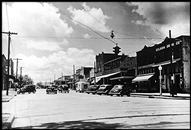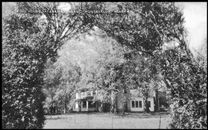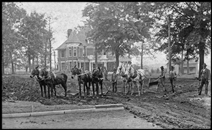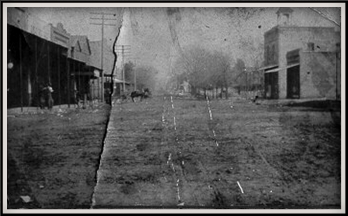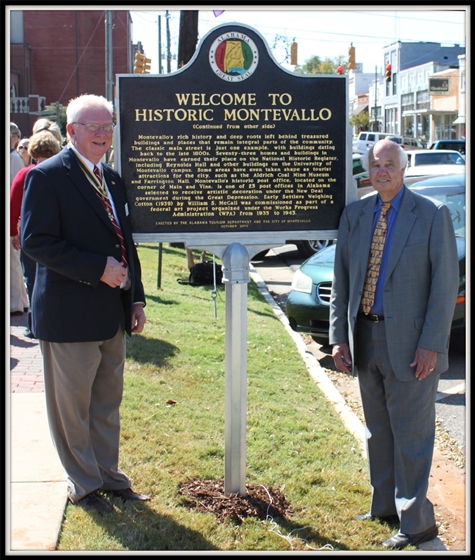Montevallo News
Copied by Bobby Joe Seales
Number One
Montevallo, as our readers all know, was originally
called Wilson's Hill. It took its name from its first citizen who was
named Wilson, an uncle to Dr. John B. Wilson, and a great uncle to Henry, Frank
and John Wilson. He arrived here from Georgia and settled at this place where he
built a log house on top of the hill near the large spring on Shoal creek. This
was in 1817, and before the state was admitted to the Union.
He was soon joined by Edmond King, who also came from
Georgia and settled on the King place. He first built a log house near the dry
branch on the Tuscaloosa road, about a hundred yards to the right of the road.
It was here that Mrs. Judge Shortridge, the mother of
Webb Shortridge, was born. King built the brick house, known as the King house,
soon after this and it was the wonder and admiration of the country for miles.
Great numbers came to see it and it was considered the finest house they had
ever seen.
He then built a brick store on the Reynolds lot, where
their warehouse now stands. He traded with Indians, shaved notes in after years
and gradually amassed a fortune. The Creek Indians lived here and cultivated
rich spots in the King, Steel and Morgan bottoms. Even now arrow heads can be
picked up in those fields. Beyond the place now owned by Jackson Gentry was
their ball ground, known as the "Indian Field." Indian pipes and other
curiosities could be found there up to time of war, also foot race tracks could
be seen there.
The Indians made an oil from hickory nuts and chestnuts
which they used in place of lard. They always raked the leaves from under the
chestnut trees so they would not be injured by fire in the woods.
Among the early settlers were the McHenrys, who settled
the Harrison place. The creek now known as King's creek was formerly called
McHenry's creek. On a beach tree near the Davis falls can now be seen the name
of McHenry cut there in 1821, seventy-four years ago. About this time, 1825, the
Bowdons moved here and settled the Killough place. It was there the talented
Frank Bowdon, Sr., of Talladega was born. The Killough mill was built by Robert
Bowdon, a great uncle of Lewis Bowdon of this place.
Thomas Walker, the father of Judge Walker, who died a
few years ago, settled what is now known as the Lawhon place and built a saw
mill and grist mill just above the ford of the Montgomery road. This was in
1835.
Old man Powell moved here from East Tennessee and
settled on the land now owned by H.C. Reynolds where he has his orchard.
Alex Nelson then moved here from East Tennessee and
married Powell's daughter. He bought the Walker property, now known as the
Lawhon place, and then built a merchant mill near the large spring at the head
of the pond and made flour and meal in large quantities. He sold his flour as
far south as Selma, Marion and Greensboro and hauled it there in wagons.
Previous to the erection of this mill wheat was carried from this section to
Prattville, Autauga county, where it was ground into flour.
The oldest house now standing in town is the two story
house near the negro church. It was built by Fred Watrous, who afterwards moved
to Texas.
It has always been understood here that this place came
within one vote of being the state capital. We are reliably informed that this
is a mistake. It did come within one vote of getting the state university away
back in the thirties. Alva Wood came here from Tuscaloosa on a committee to
select a site, and seeing the great natural advantages of this place reported
back to the legislature in favor of Wilson's Hill. In the meantime he gave it
the name of Montevallo. When left to a vote our opponent got it by one vote.
Shoal creek will be seen on the old field notes in the
original survey of 1819 as Wilson's creek.
The Mardis family were also among the early settlers.
They were all intellectual people and great believers in state's rights; so much
so they named one of the boys "States Rights," who afterwards became a
celebrated lawyer in New Orleans.
W.W. King, a son of Edmond King, also moved to New
Orleans and became one of the first lawyers there. It is said he had many cases
in the United States supreme court and never lost a case. In one case he
received a fee of $75,000, but eventually died a poor man.
The house in which church was first held was the old
masonic building which stood on the bluff above the big spring. It is said
school was taught in this building all the week and a big dance on Friday night
and Sunday school and church on Sunday. The first church and school house,
however, was built near the center of the Montevallo cemetery, down near the
Wilson spring.
Daniel Watrous also came here in the early days of
Montevallo. He emigrated from Elmira, N.Y. He was the first lawyer ever in the
town. He ran against William L. Yancy for congress. Watrous was the whig
candidate, and Yancy the state's rights democrat, commonly called "fire-eaters."
The first hotel was in the building now occupied by H.C.
& W.B. Reynolds as a store house. It was known as the Bell hotel.
Horace Ware was reared near the Thompson place, now
known as Birmingham Junction. He read law under Judge Shortridge. He afterwards
ran an iron works at Thomson's mill.
Old man Jimmy Nabors, an uncle to French Nabors, was
also one of the "old-timers," and represented the county in both branches of the
legislature. Jimmy Nabors was known as a great temperance man, and organized a
temperance club here. At that time whisky was worth twenty cents a gallon. It is
said when people in the county had a falling out they would make an appointment
to meet each other in town the following Saturday and fight it out.
One of the first and best teachers in the early days was
Prof. Livingston, a fine Greek and Latin scholar, who afterwards moved to
Talladega and married Miss Willis, a cousin of General Morgants wife.
The most noted school in all this section, however, was
at Salem graveyard. It was kept up there for three years and very often had from
75 to 150 pupils in attendance. One of the first teachers there was Prof. Billy
Peters, the father of J.L. Peters, Esq., of Columbiana - a kind gentleman and a
good teacher.
INSERT: Alabama State Gazette, (Cahaba, Alabama), dated Sunday, April 3, 1825, "CEDAR GROVE ACADEMY, MONTEVALLO, Shelby County, Alabama. This Seminary is now open for the
reception of scholars under the superintendance of D. McLeod. Terms - Spelling, Reading and Writing, $12 per annum; Arithmetic, English, Grammar, Georgraphy,
Lectures on Rhetoric and Belleslettres, History, $20; Mathematics, Logic, General Philosophy, Latin, Greek, Astronomy, $30; to be paid seim-annually in advance. Montevallo, for healthiness of
situation, purity of water and atmosphere, is not surpassed by any part of the State - we might say of the United States. Good board can be had in private families in the village
and its neighborhood on moderate terms. March 12, 1825."
"Yet he was kind, or if severe in aught,
The love he bore to learning was in fault,
While words of learned length and thundering sound
Amaz'd the gazing rustics 'ranged around,
And still they gazed and still the wonder grew
That one small head could carry all he knew -
But pass'd is all he knew. The very spot
Where many a time he triumphed is forgot."
Montevallo News
Thursday, July 25, 1895
Number Two
In our last chapter the type made us say the school
at Salem graveyard continued only three years. This was an error; it should have
said thirty years. It was a noted school in that day and time and was patronized
from miles around.
One of the old settlers of the country was Jerry Lolly,
who came here with several of his brothers and settled the Wilton Allen place,
at the crossing of the Tuscaloosa and Elyton roads. This was in 1820. They were
the ancestors of the Lolly family, who have since that time lived within a few
miles of the spot where old man Jerry Lolly first struck camp seventy-five years
ago. Along with the Lollys came Daniel and Hiram Holsomback, two sturdy old
pioneers. They too settled near Dogwood church, and their numerous descendants
still occupy that portion of the country.
About 1825 Mose Johnson came along, and at one time
lived on the McMath place, near town. His children moved to Texas. It is said
that the father of our town had quite a weakness for a good old fashioned game
of poker, and at one time in a game of cards with a Tennessean on the bluff
above the spring he won in one sitting five thousand bushels of corn.
Noah Haggard was a well known character in his day. He
was a Baptist preacher and lived near the French Nabors place, below Birmingham
Junction. At the many camp meetings he was noted for always finding the best
dinner on the grounds. He was the father of Mrs. Almoth Woods. The first church
he had was on the creek about a half mile above the Perry place. It was built of
logs in 1820. In 1846 Judge Shortridge bought the house and moved it to the
Davis place, near Aldrich. In the primitive days goods were hauled in wagons
from Selma and Wetumpka, and it is said salt was brought from Tuscaloosa on
horseback, the roads being so bad. The merchants of that day and time generally
made purchases but once a year, and the goods were on the road from one to three
months.
The first newspaper that the town had was back in the
early fifties. It was edited by a man named Norman and called the
Montevallo Herald. In an old copy of this paper can be seen an article
on the culture of apples and pears, written by the father of L.B. Musgrove, the
present United States marshal. It is in the form of a letter written to Judge
Shortridge. Norman sold the paper to Dr. Hale and Nat King. They in time sold to
Howard Shortridge, who is now living in Cisco, Texas, where he is engaged in the
paper business.
Along in the forties Hubbell Pierce came here from
Montgomery. He lived in the Fowler house, which stood in front of the Methodist
church. He died here. His sons bought the lot and house where Pat Kroell now
lives and cut down the famous weeping willow. This was a noted tree, being over
three feet in diameter and covered more ground than any tree ever known in this
county. It was known far and near and was considered a great curiosity. It stood
at the rear end of the Kroell lot. The Pierces moved from here to Montgomery.
Wash Wooten first settled the Wm. Lovelady place in
1840. He was the father of Mary, Bob and Ben Wooten and Mrs. Jack Caldwell.
"Buck" Lawler, the father of Levi Lawler, who died last year, was one of the
early settlers also. He lived on the Perry place, where his son Levi spent his
boyhood days. "Buck" Lawler, as he was familiarly known, was elected to congress
at one time over Judge Eli Shortridge. He was buried at the graveyard on the
Perry place.
Robert Caldwell, an Irishman, lived on the Wilson lot,
near the Latham hotel. He came here in 1835, and afterwards went to Nashville,
where his three sons, who were all born here; became distinguished men. One went
to congress, one a professor in the largest school there, and one was city
attorney. Caldwell's wife was sister to Judge Sam Rice's first wife and came
from South Carolina.
Among the many distinguished men whom Montevallo claims
as citizens in past years was Gen. John T. Morgan, our United States senator. He
built a house on the Vandergrift place, near Aldrich, and lived there for a
while. Ex-Gov. Rufus W. Cobb came here from Ashville, Ala., along in the fifties
and practiced law for several years.
John Large, father of Samuel J. Large of Calera, was
among the early merchants here. His store stood just below the depot in the
"bottom," where the row of houses now stands. He carried on quite a successful
business for some time. The first two stores, however, in the history of the
town were kept by Edmond King and Seth Randall. We have made mention before of
the King store, and Randall's store was at the northwest corner of the Latham
hotel lot, in a little frame building that formerly stood there.
We suppose that very few of the younger generation know
that on the corner of the lot now owned by W.B. Reynolds there once stood a
brick dwelling. In this dwelling there was a murder committed that created much
excitement at the time. Dr. Porter, a promising physician, the father of Judge
Porter of Birmingham and grandfather of Wm. A. Walker, lived there. Having had
some misunderstanding with his father-in-law, Mr. Wade, they met at Porter's
house and a difficulty took place in which Wade stabbed Porter with a dirk and
killed him. Wade's daughter, Dr. Porter's wife, was the only witness to the
tragedy, and when it came up for trial in Jefferson county her evidence cleared
her father of the murder of her husband. Daniel Watrous represented Wade and was
paid an enormous fee in negro slaves for his services. He secured a change of
venue to Jefferson county on account of the prejudice against him in this
county.
Montevallo News
Thursday, August 1, 1895
Number Three
The more we write the more we discover can be written
of the early days of this historic town. The health-giving springs and pure
mountain air were discovered and sought after long before the State of Alabama
was admitted into the Union. Many strange names appear on the headstones in our
cemeteries, and many graves go unmarked and will probably never be known.
One of the most striking epitaphs that we have seen is
that of Rev. Joshua West, who lies buried in the Montevallo cemetery. From the
History of Methodism in Alabama we gather much information regarding this
remarkable man. He was born in Rockingham County, Virginia, in 1771, and was
licensed a Methodist preacher in 1792. The following is a verbatim copy of his
license to preach: "This may certify to whom it may concern, that Joshua West is
permitted as a local preacher in the Methodist Episcopal Church. Given under my
hand this 17th day Oct., 1792. Bennet Maxey, E.M.E.C."
Maxey was the preacher in charge of Bottetourt Circuit,
Virginia. His license to preach, his credentials to the orders of deacon and
elder and his certificate to Bishop Asbury with his own signature, certifying to
his belief of Methodist doctrine, etc., are all in a good state of preservation,
clean and legible, and are on file in the archives of the Methodist Conference.
Dr. West was also a physician and did an extensive
practice. He came to Alabama in 1816, and spent most of his life at Montevallo.
He practiced medicine as far south as to where he and the physician from Cahaba
met, there being no such place then as Selma.
Soon after he came to Alabama he, assisted by Lovelady,
Lee, Powell, Walker, and others, established camp grounds about a mile from
Montevallo, just below the cemetery on the Wilson Branch. Meetings were held
here for some years. After this camp ground was abandoned another named
Ebenezer, for the Rev. Ebenezer Hearn, was established about five miles north of
Montevallo.
He brought up a family of eleven children, five sons and
six daughters. Rev. Sam P. West is one of his grandsons. John P. Morgan, the
father of Sam and George Morgan, was also one of his grandsons.
Dr. West died in 1860, being 91 years of age.
Among the early settlers were the McElroys, who came
from South Carolina in 1821. Maj. Jacob Perry and Wm. Moore married two of the
McElroy daughters and the remaining members of the family moved to Louisiana.
The father of Thos. Harrison and grandfather of the
Harrison boys, Henry, Frank and George, came to this section of the country from
Tennessee in 1818 and settled on the Ad. Griffin place. He brought his corn with
him and had to make frequent trips back to Tennessee after more corn, owing to
the fact that the country was all woodland and no open land for cultivation.
Between 1825 and 1830 Dr. Wheeler Randall emigrated from
South Carolina and settled the Meroney place. He was a physician of much
reputation, and had two sons who afterwards became celebrated physicians in
Galveston, Tex. This family were not related to the ancestors of the Randall
family now living here, of whom we make mention later on in our sketches.
Dudley Randall, representative of another Randall
family, was a man of large property and married a daughter of Mrs. Powell and
lived in the house on Main street south of Kroell's store.
Daniel Prentice was one of the original and striking
characters who lived here previous to the war. He was a man of much influence
and merchandised here for many years. His name as Justice of the Peace appears
on many old papers.
The first Methodist preacher on this circuit was named
Powell. This must have been in 1820. His circuit extended from Cox's Chapel,
below Randolph, to the Isaac Johnson place at Highland.
The oldest known grave in the Montevallo cemetery is
that of Jane McQuirter, whose tomb bears this inscription: "Sacred to the memory
of Jane McQuirter, born in the year 1800, died 1820." We fail to get any
information whatever of such a family and will be under obligations for facts
concerning them.
We notice another tombstone which was erected to
Elizabeth Wilson, who was born in 1807 and died in 1822. She no doubt was a
daughter of the founder of our town. Her mother, Elizabeth Wilson, also wife of
Jesse Wilson, lies buried by her side. She was born in 1779 and died in 1830.
There are no doubt graves in this cemetery nearly a
century old, but in the early days but few tombstones were used and the last
resting places of many are no doubt now lost to view.
Montevallo News
Thursday, August 15, 1895
Number Four
In the year 1815, just 80 years ago this fall, there
might have been seen a company of men, women and children leaving Edgefield
District, South Carolina, for the country now known as the State of Alabama. For
months they journeyed through practically a wilderness until they reached the
vicinity of Montevallo. There they rested, and there they and their descendants
have lived up till this good hour. This party had in it Abram Holsomback, the
father of John Holsomback, who lived for some time near Thompson's mill. There
his son John was born on March 28, 1818. This makes him one of the oldest
citizens in this section.
Henry Lolly, the father of Joe and Lewis Lolly, was also
of the same party. Jesse Lolly, the father of William Lolly, also came at the
same time. The oldest one of these pioneers, however, is Andrew Lolly, who is
hale and hearty and is now approaching the ripe old age of 90.
Among the others were Vince Garner, grandfather of Lewis
Garner; George Lucas, father of Wm. and John Lucas; John Walker, the father of
Elias Walker; Abner Pickett, the father of Braz. Pickett, and John Lolly, the
father of Mrs. Fronia Lucus.
The descendants of these early settlers recollect the
Indians whom they found here on their arrival and, strange to say, we have found
no instance of disturbance between them during their joint occupancy of the
country. Mr. John Holsomback remembers while a boy to have seen an Indian bring
a large fine deer to his mother's house and sold it to her for a gallon of meal
and a pint of salt. At that time salt was very scarce and high. Cotton was sold
in the seed to merchants, who had it ginned and shipped.
Maj. Jacob Perry and Wm. Moore were two early settlers
of the country. They came about 1825. Major Perry first lived near the Salem
grave yard. Both of these old patriarchs lived to a ripe old age and died
honored and respected by all who knew them.
Maj. Abner Wells came to this place along in the early
forties. He was a major of the militia. The mustering of the troops known as
"Muster Day," was a gala day. Very often, in the absence of guns, they used corn
stalks and sticks for drilling purposes.
Major Wells kept the "tavern" on the Walker
corner for a long time. He married the daughter of Joseph Cunningham and left a
large family, some of whom still live in our midst. The old tavern bell which he
used, now hangs in the colored church.
Montevallo News
Thursday, September 5, 1895
Number Five
Among the many notable men who have been reared in
our historic old town, may be mentioned Judge George D. Shortridge. He was a son
of Judge Eli Shortridge who lived in Tuscaloosa. Judge George Shortridge was
born near Lexington, Ky., and moved to Montevallo from Montgomery in 1844. His
father was one of the first circuit judges of the state.
His mantle seems to have fallen on his son George who
also became a circuit judge presided in Bibb, Jefferson and other counties. He
was the know nothing candidate for governor before the war and was defeated by
John A. Winston. He married a daughter of Edmond King and his daughter, Mrs.
R.R. Gaines, now lives in Palestine, Texas, the wife of the chief justice of the
supreme court of that state.
Mrs. Lou Gaines and W.W. Shortridge died in 1870 and
lies buried in the family burial ground on the King place.
It is said that in the early history of the town
panthers were very common and sometimes came within the corporate limits. The
last one killed here was by Dr. Mardis and Edmond King. They had been out in the
country and coming back they saw a large panther run up a tree near the
Vandegrift place. Dr. Mardis stayed near by while Mr. King galloped up to his
house and got his gun and killed it. Its skin was said to be a beauty and was
displayed for many years at the King homestead.
Along in the fifties the railroad fever sprang up and
created great excitement for a while. It is said that even the women all through
the country knit socks and turned them over to the committee for the benefit of
the railroad. Edmond King gave $20,000 in money and an engine worth $15,000. In
1855 the Alabama & Tennessee River railroad laid its first iron in our town, and
for several years this was the terminus.
With the road came a new population and new life -
making it for a few years the largest market in North Alabama. Cotton was
marketed here from Calhoun, Talladega, Blount, St. Clair, Jefferson, Walker,
Bibb and Tuscaloosa counties.
In one season the old railroad books show a total
shipment of 24,000 bales. In that day and time cotton frequently brought as much
as 50 cents a pound. We find in old cotton books kept by merchants then where a
heavy bale of cotton brought as much as $300.
Among the inhabitants the railroad brought to the town
were the Riddle Bro's, who built the road from Selma to this point. They built
the store house now belonging to George Kroell where for several years they
carried on a large and lucrative business. Robinson & DeJarnette built the
Vandegrift house. They came from Augauga and Lowndes. Harrison & Gregory were
also large dealers and did business in a storehouse between Morgan & Merony's
and Latham & Co's. places of business.
Cunningham & West were also merchants, having bought out
Dan Prentice. Goods were sold on open account to any one and it is said very
little money was ever lost until after the war. Notes and mortgages were unknown
and every man was put on his honor and very few ever went back on it.
About the time the railroad came, the town got on what
is now known as a "boom." The female college was erected and the Baptist church,
a brick building, was erected near the residence of Mr. C.C. Vandegrift. The
college was built by general subscription. The lot was donated by Edmond King,
who, as usual, took the lead in all public matters pertaining to the advancement
of the town. The house was built by Gen. Charles M. Shelly and his father and
stands a monument today of their skilled workmanship. The school was first
taught by Prof. Robert S. Lewis who came here from Howard College. It eventually
developed into a sectarian school and Professor Lewis was disposed of.
Lewis was succeeded by Hodson a gentleman from
Massachusetts. It was then purchased by the Cumberland Presbyterian church who
were at that time in the ascendancy and changed to a female college. It finally
was placed in the hands of Dr. Meredith who lived and taught school in it for
many years. When it was changed to a female college the citizens got up money
and built what is now known as Lyman's Hall where a male and female school has
been taught ever since. Among the many teachers who have held sway in the old
town was quite an oddity in the person of "old man Murell" as he was familiarly
known. He was a large, stout Irishman and believed in the free use of the rod -
so much so that he frequently used it on the parents as well as the children, as
he held the parents accountable for the conduct of his children and would whip
them too if they disputed his authority or interfered in any way with his
discipline of the children. He was a terror to the boys and there are no doubt
many who read these sketches who have vivid recollections of his skill in the
use of the rod.
The Shelby Chronicle
~ Trade Issue ~
Thursday, December 29, 1887
Montevallo.
Montevallo is one of the largest towns in Shelby
County, lying on the S. R. & D. R.R., and was settled about the year 1825. It is
within five miles of the geographical center of the State of Alabama. It came
within one vote of being selected as the capital of the State when it was
determined to remove the capital from Cahawba. No site could be found for a
town, large or small, more admirably suited. The natural drainage is perfect.
One or more perennial and swift-flowing streams run near it, sufficient to
supply outlet for sewerage. Water is abundant and of the best kind. The panorama
is delightful. For many miles away, the wealth in coal and iron and limestone
and timber, which lie almost at its doors, extends with limitless profusion.
The agricultural lands in easy reach are very fertile.
The salubrity of the climate is unsurpassed. The original charter of the North &
South Railroad required it to intersect the Alabama and Tennessee Rivers (now S.
R. & D.) Railroad at Montevallo.
So delightful a place of abode, has long attracted to it
some of the most prosperous and eminent men of the state. The churches and
schools are well maintained, and a high moral atmosphere prevails. The
compulsory abandonment of the saloons has been a God-send to the place. The
nearness of the mining and manufacturing towns, Aldrich and Brierfield, have
added commercial importance to Montevallo, and while intoxicating liquors are
denied the miners, peace prevails on Saturdays, and cash freely flows into the
merchants' coffers.
The cotton trade is about 1,500 bales, and the general
outgoing commerce is about $60, 000 per year. Aldrich, two miles off, does a
large trade for a town of 600 inhabitants.
Copyright - Bobby Joe Seales - 2000
|
